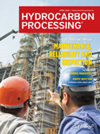March 2019
Columns
Executive Viewpoint: Introducing the refinery of the future
Businesses that develop and commercialize process technology are in a unique position to identify and evaluate global trends in our industry.

 COPYING AND DISTRIBUTING ARE PROHIBITED WITHOUT PERMISSION OF THE PUBLISHER
COPYING AND DISTRIBUTING ARE PROHIBITED WITHOUT PERMISSION OF THE PUBLISHER
Businesses that develop and commercialize process technology are in a unique position to identify and evaluate global trends in our industry.

Comments